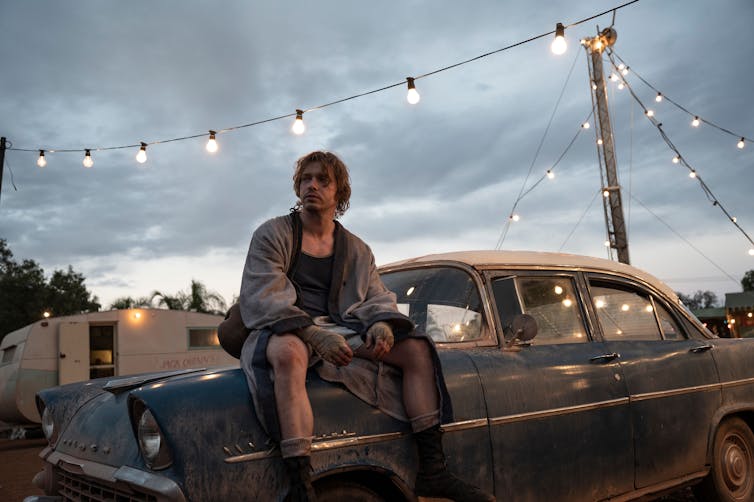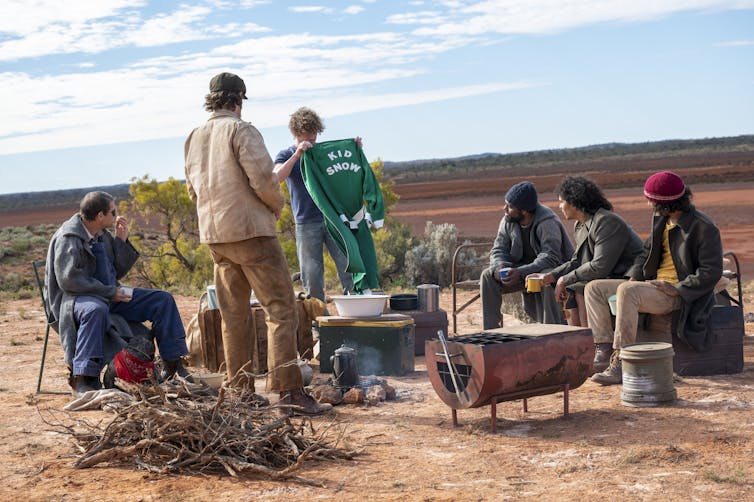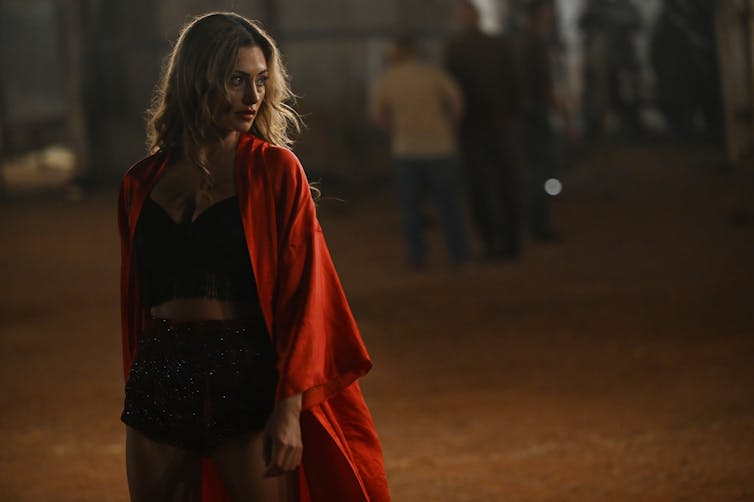Source: The Conversation (Au and NZ) – By Gemma Blackwood, Lecturer, Media, University of Tasmania
Director Paul Goldman’s new Australian film Kid Snow is set in the gritty, male-dominated world of tent boxing in outback Western Australia.
The film presents itself as a reflection on the intergenerational violence caused by masculine value systems, as played out through the relationship between two Irish brothers, Kid Snow (Billy Howie) and Rory Quinn (Tom Bateman).
However, despite strong acting performances and stunning visuals, some of the plot and character elements end up feeling stereotypical and contrived – and Kid Snow fails to pack a punch.
A rivalry between brothers
It is 1971 and Kid Snow and Rory are dealing with simmering resentment and guilt linked to a past trauma.
Ten years earlier, the brothers survived a car accident at the hands of Snow that killed their father and left Rory with a crippling injury that curtailed his boxing career.
The accident also came just after Snow suffered a humiliating loss to a boxer called Hammer Morino (Tristan Gorey), who went on to become an international star.
Fast-forward to the present and Snow has become the main boxer in Rory’s tent boxing troupe: a small-time circus that tours regional Western Australia. While their lives in the outback allow small moments of beauty, there’s a sense the brothers are mired in their situation: washed up and without chance for escape.
This all changes as two new opportunities appear simultaneously. The first is a high-profile rematch between Kid Snow and Hammer Morino. The second is the arrival of Sunny (Phoebe Tonkin), a single mother escaping her own traumatic past in Sydney with her young son Darcy (Jack LaTorre) in tow.
Sunny joins Rory’s troupe as an exotic dancer. She and Darcy quickly connect with Snow, flaring up a jealous rivalry between the brothers. The budding relationship between Snow and Sunny – and the fallout between the brothers – form the main drama of the film.

Madman
A toned-down approach
While Kid Snow might initially seem like “Rocky, but in the outback”, boxing culture comes second to the interpersonal drama in the film. And unlike Rocky, the violence is downplayed.
This might disappoint fans of the sport, or of other fight-based films that deliver on visceral action (like Furiosa, for instance, which was also shot in the outback).

Madman
The boxing storyline eventually feels like a Hitchcockian “McGuffin”, falling away despite its initial, expository significance.
By removing the brutal realities of boxing, Kid Snow seems to romanticise the sport, and in doing so takes away from the exploration into hyper-masculinity (and its overlap with violence and brutality) in Australian culture.
A visually striking outback film
There is a pleasure in watching Kid Snow as an example of an outback film, with cinematographer Gary Phillips providing a beautiful lensing of the West Australian landscape and its attendant bright skies.
Tourism researcher Warwick Frost has studied the narratives of the outback film subgenre and finds that these films often feature an outsider’s perspective on the location, which itself is usually framed as a place for “life-changing” and profound experiences.
In Kid Snow, this outsider perspective comes from Sunny – and certainly the outback setting is a conduit for several of the main characters’ life-changing experiences.
However, many supporting characters, including the Indigenous characters Lovely (Mark Coles Smith) and Lizard (Hunter Page-Lochard), have limited impact on the broader story.
This seems like a missed opportunity for a more nuanced and inclusive gaze on this outback community, especially given the calibre of the actors involved.

Madman
Ultimately a letdown
It seems fitting that much of the film takes place in the year 1971. This was an important year for cinema set in the outback.
It’s the same year Ted Kotcheff’s Wake in Fright was released. This film demonstrates the loneliness felt by men and women in a frontier town where forced and brutalising codes of mateship lead to spiritual disconnection and despair.
The film carefully examines the isolation and ugliness caused by colonial forms of masculinity – offering a strong critique of white machismo culture.
Kid Snow does share some similarities with Wake in Fright, such as in how the brothers seem trapped in their outback lives, with its endless skirmishes, injuries and drunken hangovers.
But unlike Wake in Fright, Kid Snow allows redemption for its eponymous main character. Snow gets a chance to move on, heal from the past and find a meaningful romantic connection with Sunny. This upbeat ending for the anti-hero feels unearned.

Madman
The film draws upon narrative cliches that seem to place the white, male experience above others. Kid Snow and Rory have the most agency in the film, while Sunny’s character arc seems predicated around the gaze of the brothers, as if she is a prize to be allocated to the most worthy.
One scene of an attempted sexual assault of Sunny by jealous Rory also isn’t addressed later by the brothers, reinforcing the film’s patriarchal focus.

Madman
Ultimately, Kid Snow feels like a missed opportunity for a deeper exploration into the politics of white Australian masculinity and its interconnection with gender, class and race.
Delivering this could have had a profound impact, as such generic conventions are ripe for challenge in Australian film.
Kid Snow is in cinemas from today.
![]()
Gemma Blackwood does not work for, consult, own shares in or receive funding from any company or organisation that would benefit from this article, and has disclosed no relevant affiliations beyond their academic appointment.
– ref. Kid Snow takes a stab at exploring masculinity in the gritty outback, but fails to land – https://theconversation.com/kid-snow-takes-a-stab-at-exploring-masculinity-in-the-gritty-outback-but-fails-to-land-238212









